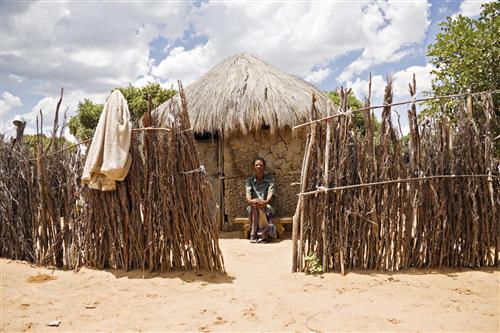This story from the Fish River Canyon area, in southern Namibia, is from a book called 'Muzimbikana and Other Namibian Adventures', created by the Namibia Oral Tradition Project (1997). It has been reproduced with kind permission from Gamsberg-MacMillan Books and New Namibia Books, Namibia.
One cold winter morning in the dry Kalahari desert, a dark-skinned Bushman* armed with bow and poisoned arrow, sniffed the fresh morning air for the distinctive scent of a wild duiker. For the previous four days the unfortunate Bushman had not been able to find any food or water. Though tired and miserable, he still did not allow himself to rest or sleep, for he had to find food and water before noon, or he would starve.
Strangely, his luck turned as he crawled across a small dune. Behind the dune stood two duikers, drinking their early morning sip, and at the waterhole a young warthog played in the mud.
He took his aim, and there was a lethal swoosh from the arrow. A duiker shot up into the air and plunged softly down into the red Kalahari sand, staining the sand in a dark red pool of blood. Suddenly all went silent, even the birds ceased to sing their usual happy tunes. It was as if the animals communicated with each other and warned one another not to return to the waterhole.
The man felt contented because he had found a sire with adequate food and water. He decided therefore to settle there for a month and plan his future movements from there. He used some long, thin branches, shaped them in the shape of a dome and partially covered the naked dome with the skin of some of the animals he had killed during the previous three months; the rest he covered with tall grass from the plain across the northern dune.
During the month he hunted, collected water, made arrows and collected poison for his arrowheads. Each cold night he would go to sleep just after the last orange rays of dusk crawled down behind the western horizon, but one strange and exceptionally cold night a loud thundering and trumpeting woke him moments after he fell asleep. He jumped up and went outside his hut, but found it too dark to see, and so went back into his hut to continue sleeping. He would go and investigate the cause of the noise in the morning.

A traditional San dwelling.
Source:iStockphoto/Poco 2009
( click to enlarge )
Dawn broke and the old man left the warmth of the fire in the cold morning air. He headed in the direction that the noise had come from, armed with bow and poisoned arrow. He crossed the grassy palm and, at the far end of the plain, the dune, and finally came to a stop at the edge of a very deep ravine, many kilometres from his hut. Down at the dark bottom of the ravine lay the grey silhouette of an old elephant bull that was dead: But as the Bushman narrowed his eyes to look deeper down into the ravine, he saw with amazement that there lay several thousand more skeletons and half decayed carcasses of other elephants. That must be the noise he heard last night: this elephant was wounded and was going to die and with its last strength made its way towards the ravine. Several other elephants accompanied it, but must have left after it plunged from the edge down into the deep, dark grave.
The Bushman had heard of such elephant graves but had never seen one or witnessed such occasion until now.
Several weeks passed and the time to leave came but during those weeks many elephants died in the ravine. The Bushman came to love those big mammals more and more. Sometimes he came very close to a herd of elephants. They became like friends to him.
But on one fateful spring day a lion attacked the old Bushman while he was tracking a duiker. They fought for quite some time, until at last the Bushman managed to pull a poisoned arrow from his leather quiver and stabbed the lion in its chest with much pain and effort. The old man struggled towards his hut. He had lost a lot of blood and was becoming weaker by the minute. He reached his hut and sank down to his knees. He had reached the end of his life and knew it.
At dusk the old man extinguished the flickering fire, threw his bow and quiver across his tormented back and battled against pain as he struggled north, across the grassy plain and over the dunes and off the palm towards the edge of the deep, dark ravine. The soft gravel crumbled underneath his feet as he crashed onto the cold white skeletons and brilliantly white tusks.
Only a faint cry echoed across the dune at the edge of the grassy plain, and on towards the south, across the plain, and ended bluntly at the drinking hole where the zebra, duiker and warthog used to come to drink.
* member of the San people
